Related Research Articles
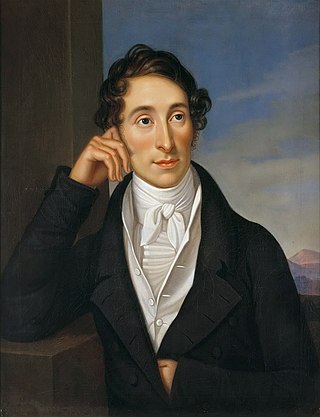
Carl Maria Friedrich Ernst von Weber was a German composer, conductor, virtuoso pianist, guitarist, and critic of the early Romantic period. Best known for his operas, he was a crucial figure in the development of German Romantische Oper.
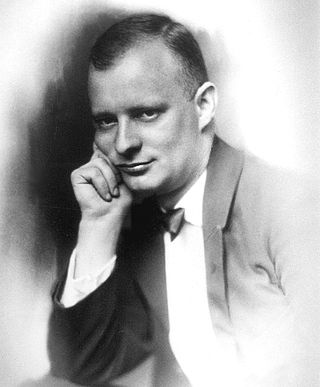
Paul Hindemith was a German and American composer, music theorist, teacher, violist and conductor. He founded the Amar Quartet in 1921, touring extensively in Europe. As a composer, he became a major advocate of the Neue Sachlichkeit style of music in the 1920s, with compositions such as Kammermusik, including works with viola and viola d'amore as solo instruments in a neo-Bachian spirit. Other notable compositions include his song cycle Das Marienleben (1923), Der Schwanendreher for viola and orchestra (1935), the opera Mathis der Maler (1938), the Symphonic Metamorphosis of Themes by Carl Maria von Weber (1943), and the oratorio When Lilacs Last in the Dooryard Bloom'd (1946), a requiem based on Walt Whitman's poem. Hindemith and his wife emigrated to Switzerland and the United States ahead of World War II, after worsening difficulties with the Nazi German regime. In his later years, he conducted and recorded much of his own music.

Tubular bells (also known as chimes) are musical instruments in the percussion family. Their sound resembles that of church bells, carillons, or a bell tower; the original tubular bells were made to duplicate the sound of church bells within an ensemble. Each bell is a metal tube, 30–38 mm (1+1⁄4–1+1⁄2 in) in diameter, tuned by altering its length. Its standard range is C4–F5, though many professional instruments reach G5. Tubular bells are often replaced by studio chimes, which are a smaller and usually less expensive instrument. Studio chimes are similar in appearance to tubular bells, but each bell has a smaller diameter than the corresponding bell on tubular bells.

George Balanchine was an American ballet choreographer of Georgian origin, recognized as one of the most influential choreographers of the 20th-century. Styled as the father of American ballet, he co-founded the New York City Ballet and remained its artistic director for more than 35 years. His choreography is characterized by plotless ballets with minimal costume and décor, performed to classical and neoclassical music.

New York City Ballet (NYCB) is a ballet company founded in 1948 by choreographer George Balanchine and Lincoln Kirstein. Balanchine and Jerome Robbins are considered the founding choreographers of the company. Léon Barzin was the company's first music director. City Ballet grew out of earlier troupes: the Producing Company of the School of American Ballet, 1934; the American Ballet, 1935, and Ballet Caravan, 1936, which merged into American Ballet Caravan, 1941; and directly from the Ballet Society, 1946.
The Locrian mode is the seventh mode of the major scale. It is either a musical mode or simply a diatonic scale. On the piano, it is the scale that starts with B and only uses the white keys from there. Its ascending form consists of the key note, then: half step, whole step, whole step, half step, whole step, whole step, whole step.
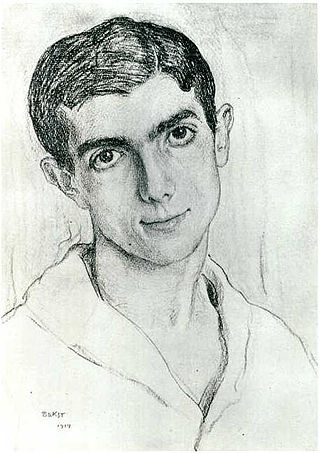
Leonid Fyodorovich Myasin, better known in the West by the French transliteration as Léonide Massine, was a Russian choreographer and ballet dancer. Massine created the world's first symphonic ballet, Les Présages, and many others in the same vein. Besides his "symphonic ballets," Massine choreographed many other popular works during his long career, some of which were serious and dramatic, and others lighthearted and romantic. He created some of his most famous roles in his own comic works, among them the Can-Can Dancer in La Boutique fantasque (1919), the Hussar in Le Beau Danube (1924), and, perhaps best known of all, the Peruvian in Gaîté Parisienne (1938). Today his oeuvre is represented by his son Lorca Massine, who stages his works around the world.
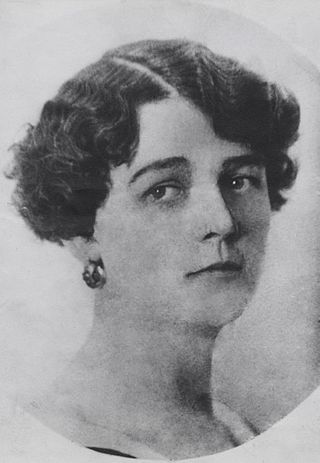
Varvara Jmoudsky, better known as Barbara Karinska or simply Karinska, was the Oscar-winning costumier of cinema, ballet, musical and dramatic theatre, lyric opera and ice spectacles. Over her 50-year career, that began at age 41, Karinska earned legendary status time and again through her continuing collaborations with stage designers including Christian Bérard, André Derain, Irene Sharaff, Raoul Pêne du Bois and Cecil Beaton; performer-producers Louis Jouvet and Sonja Henie; ballet producers René Blum, Colonel de Basil and Serge Denham. Her longest and most renown collaboration was with choreographer George Balanchine for more than seventy ballets — the first known to be “The Celebrated Popoff Porcelain,” a one act ballet for Nikita Balieff's 1929 La Chauve-Souris with music by Tchaikovsky for which Karinska executed the costumes design by Sergey Tchekhonin. She began to design costumes for Balanchine ballets in 1949 with Emmanuel Chabrier's “Bourrèe Fantasque,” for the newly founded New York City Ballet. Their final collaboration was the 1977 "Vienna Waltzes.” Balanchine and Karinska together developed the American tutu ballet costume[9] which became an international costume standard.
Johannes Paul Thilman was a German composer.
Keith L. Wilson was an American classical musician. He was a clarinetist, teacher, and conductor.
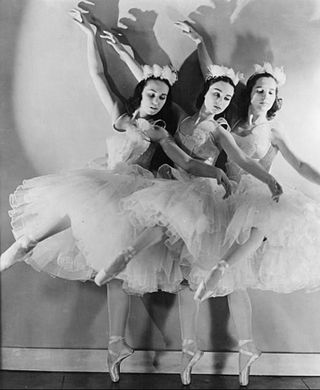
The company Ballets Russes de Monte-Carlo was formed in 1932 after the death of Sergei Diaghilev and the demise of Ballets Russes. Its director was Wassily de Basil, and its artistic director was René Blum. They fell out in 1936 and the company split. The part which de Basil retained went through two name changes before becoming the Original Ballet Russe. Blum founded Les Ballets de Monte Carlo, which changed its name to Ballet Russe de Monte Carlo when Léonide Massine became artistic director in 1938. It operated under this name until it disbanded some 20 years later.
Symphony in C, originally titled Le Palais de Cristal, is a ballet choreographed by George Balanchine, to Georges Bizet's Symphony in C. The ballet was originally created for the Paris Opera Ballet, and premiered on July 28, 1947 at Théâtre National de l'Opéra.
The Original Ballet Russe was a ballet company established in 1931 by René Blum and Colonel Wassily de Basil as a successor to the Ballets Russes, founded in 1909 by Sergei Diaghilev. The company assumed the new name Original Ballet Russe after a split between de Basil and Blum. De Basil led the renamed company, while Blum and others founded a new company under the name Ballet Russe de Monte-Carlo. It was a large scale professional ballet company which toured extensively in Europe, Australia and New Zealand, the United States, and Central and South America. It closed down operations in 1947.
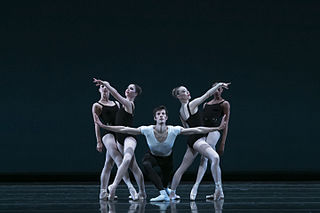
The Four Temperaments or Theme and Four Variations is an orchestral work and ballet by Paul Hindemith. Although it was originally conceived as a ballet for Léonide Massine, the score was ultimately completed as a commission for George Balanchine, who subsequently choreographed it as a neoclassical ballet based on the theory of the four temperaments.
Nobilissima visione is a 50-minute ballet in six scenes by Paul Hindemith, originally choreographed by Léonide Massine for the Ballet Russe de Monte Carlo. The libretto by Hindemith and Massine depicts episodes from the life of Saint Francis of Assisi. The work was completed in February 1938 and premiered at Theatre Royal, Drury Lane in London on 21 July 1938, with sets and costumes by Pavel Tchelitchew and under the baton of the composer. He led one performance of the new ballet at the Metropolitan Opera House in New York on 14 October of the same year.
Symphonic Variations may refer to:

Francisco Moncion was a charter member of the New York City Ballet. Over the course of his long career, spanning some forty years, he created roles in major works by George Balanchine, Jerome Robbins, and others. He was also a choreographer himself and a talented amateur painter.
Lorca Massine is an American choreographer and dancer born in New York on July 25, 1944, to choreographer Léonide Massine, a Russian immigrant. He studied dance with his father, Victor Gsovsky, Asaf Messerer and Anatole Wilzac. Over his career, Lorca Massine has collaborated with world-acclaimed choreographers such as Balanchine, Béjart, and his father, Léonide Massine,.
Kammermusik No. 2 is a ballet choreographed by George Balanchine to Paul Hindemith's music of the same name. The ballet premiered on January 26, 1978, at the New York State Theater, danced by the New York City Ballet.
References
- Luttmann, Stephen (2009). Paul Hindemith: A Research and Information Guide. Routledge Music Bibliographies (2nd ed.). New York City and London: Routledge. ISBN 9780415994163. Ebook: ISBN 978-0-203-89126-1
- Sadie, Stanley; Tyrrell, John, eds. (2001). The New Grove Dictionary of Music and Musicians (2nd ed.). London: Macmillan. ISBN 9780195170672.
Footnotes
- ↑ Luttmann 2009, pp. 335–6.
- 1 2 Luttmann 2009, p. 335.
- ↑ New Grove Dict. M&M 2001, "Hindemith, Paul" by Giselher Schubert.
- ↑ Anderson, Gene. 1996. "The Triumph of Timelessness over Time in Hindemith's 'Turandot Scherzo' from Symphonic Metamorphosis of Themes by Carl Maria von Weber". College Music Symposium 36:1–15. p. 1.
- ↑ New Grove Dict. M&M 2001, "Weber: (9) Carl Maria (Friedrich Ernst) von Weber" by Michael C. Tusa.
- ↑ Downes, Olin (1944-01-21). "RODZINSKI OFFERS HINDEMITH MUSIC; Hubermann Heard in Brahms Concerto--Nies-Berger at Organ in Handel Piece". The New York Times. ISSN 0362-4331 . Retrieved 2021-08-18.
- ↑ "The Week's Programs: Ballet Artists Returning—Concerts and Recitals". The New York Times. 16 November 1952. X13.
- ↑ "This Week's Events: Balanchine-Hindemith Ballet in Premiere". The New York Times. 23 November 1952. X12.
- ↑ M[artin], J[ohn] (26 November 1952). "Ballet Presents Another Novelty: Metamorphoses Makes Use of Collaboration of Karinska, Balanchine and Hindemith". The New York Times. p. 20.
- ↑ M[artin], J[ohn] (27 January 1954). "Leclercq Has Lead in 'Metamorphoses'". The New York Times. p. 23.
- ↑ Luttmann 2009, p. 336.
- ↑ Kriegsman, Alan M. (16 August 1990). "Dance; Miami Spice; At Wolf Trap, a Dash of Balanchine". Washington Post. C01.
- ↑ Anderson, Jack (12 March 1991). "Review/Dance; Japanese Choreography In Contemporary Works". The New York Times. C14.